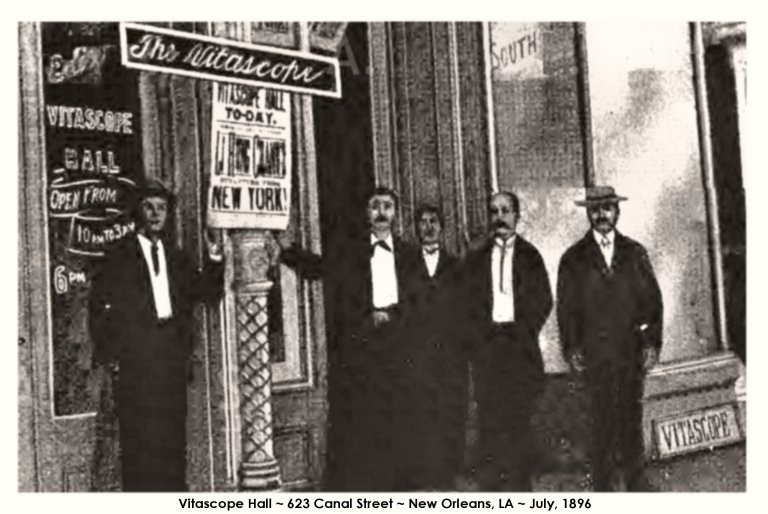Vitascope Hall (1896) Historical Marker
Introduction
Text-to-speech Audio
In 1896, this was the home of the first indoor commercial movie theater in the United States, Vitascope Hall, a reference to the projector that was utilized to show short moving pictures. In contrast to the ornate theaters of the era that hosted live events, Vitascope Hall was simply a storefront that was operated by William “Pop” Rock and Walter Wainwright. The pair had the idea of exhibiting Vitascope films during the day following their success and growing crowds who came to watch outdoor projections in the evening. The business was likely too ahead of its time, and the small storefront theater only operated for a few months owing to the novelty of the idea and scarce supply of films. In the decade that followed, a burgeoning film industry supported the creation of longer and more technically-advanced motion pictures which led to the commercial viability and rapid proliferation of movie theaters in the early 20th century.
Images
Vitascope Hall, July 1896.

Backstory and Context
Text-to-speech Audio
Vitascope Hall in New Orleans was named after the projector it used: Edison’s Vitascope. Edison did not actually invent the Vitascope, however. The invention came to life as the Phantoscope, a product of the minds of Charles Francis Jenkins and Thomas Armat. Before it and the Cinématographe developed by the Lumiere brothers, films could only be viewed one person at a time via “peep” machines. Projecting moving images onto a screen would allow for more viewers per film and therefore more profits for exhibitors. Jenkins and Armat filed a patent for their Phantoscope in July 1895, then another in 1896 for an improved version of the same projector. Jenkins and Armat would split ways, but before they did, they sold the rights of distribution to Thomas Edison and the Raff & Gammon firm. The name was changed to the “Edison Vitascope” for marketability. The reimagined projector made its debut in Koster and Bial’s Music Hall in New York City. Afterward, Edison and Raff & Gammon sold exclusive territorial rights for the technology.
William “Pop” Rock, a British businessman, bought the rights to use the Vitascope in Louisiana. To help him in his new endeavor, Rock enlisted the help of carnival showman Walter Wainwright and the projectionist Walter A. Reed. They decided to try out their new projector in the West End of New Orleans, an area known for family-friendly entertainment. Knowing that the projection of films may not be enough of a spectacle to entice customers, the trio hired a band to play alongside the movie showings. Rock and his partners exhibited “Edison’s Wonderful Vitascope” for the first time on June 28th, 1896. They had a hit and decided to do something risky: project the films for paying customers inside a dedicated storefront.
Rock and Wainwright bought an empty storefront on Canal Street in the commercial heart of New Orleans. They Blacked out the windows, bought benches and folding chairs from a closing funeral parlor, and set the Vitascope projector on a cart so that it could be wheeled closer to or farther from the screen as needed. When it opened later that summer, Vitascope Hall became the first for-profit, indoor movie theater with seating. Before it, most places that projected motion pictures were standing-room-only or were free experimental showings with seats. Wainwright advertised in a local newspaper weekly with sensational claims and coupons to bring in audiences. Visitors to Vitascope Hall could pay extra to see the projection booth and take home scraps of film. After a profitable run, Vitascope Hall closed on September 30th, 1896. Rock and Reed continued to exhibit Vitascope films throughout Louisiana for another year. Rock would then go on to become president of Vitascope Productions.
Though it was just a projector in a storefront with a few hundred seats and might be understood today as a "pop-up" theater, Vitascope Hall offered a glimpse of the future with indoor seating and projection. In 1925, film historian H. E. Richardson determined that Vitascope Hall was the first commercial movie theater, and his work was later cited by British researcher Patrick Robertson in the 1960s. The storefront that housed Vitascope Hall has since been home to a variety of retail and fast-food ventures. The site remains unmarked, though a nearby hotel restaurant bears the name “Vitascope Hall.”
Sources
First movie projector demonstrated in United States. History.com. Accessed March 05, 2018. http://www.history.com/this-day-in-history/first-movie-projector-demonstrated-in-united-states.
Vitascope Hall - America's First Movie Theater. YouTube. July 23, 2016. Accessed March 05, 2018. https://www.youtube.com/watch?v=ZXKygZCAENk&pbjreload=10.
"Vitascope." A/V A to Z: An Encyclopedic Dictionary of Media, Entertainment and Other Audiovisual Terms, Richard W. Kroon, McFarland, 1st edition, 2014. Credo Reference, https://marshall.idm.oclc.org/login?url=https://search.credoreference.com/content/entry/mcfav/vitasc.... Accessed 27 Feb 2018.
Keith, Don L. "The First Picture show." New Orleans Magazine, vol. 30, no. 10, 07, 1996, pp. 64, eLibrary, https://search-proquest-com.marshall.idm.oclc.org/docview/206635997?accountid=12281.
Scott, Mike. The story of Canal Street's Vitascope Hall, the world's first movie theater. The Times Picayune. June 18, 2017. Accessed March 05, 2018. http://www.nola.com/300/2017/06/vitascope_hall_new_orleans_fir.html.
Thurman, Linda. America's First Movie Theater: Vitascope Hall. LindaThruman.com. June 03, 2016. Accessed March 05, 2018. https://lindathurman.com/2016/06/07/americas-first-movie-theater-vitascope-hall/. Photo source.
Film Tour. Tour New Orleans. Accessed March 05, 2018. http://www.tourneworleans.com/film.html. Photo source.
